Business Procurement and Contractual Practice
VerifiedAdded on 2022/12/15
|11
|4021
|277
AI Summary
This document discusses the conditions of contracts in the procurement method and the standard form of contract and dispute resolution in case of breach of civil law or tort. It explores different types of procurement contracts and their advantages. It also explains the role of torts in construction contracts and the defences available. Additionally, it provides insights into the guidelines for dealing with delays caused by employers in construction contracts and discusses the General Conditions of Contract published by FIDIC.
Contribute Materials
Your contribution can guide someone’s learning journey. Share your
documents today.

Business procurement
and Contractual
Practice
and Contractual
Practice
Secure Best Marks with AI Grader
Need help grading? Try our AI Grader for instant feedback on your assignments.
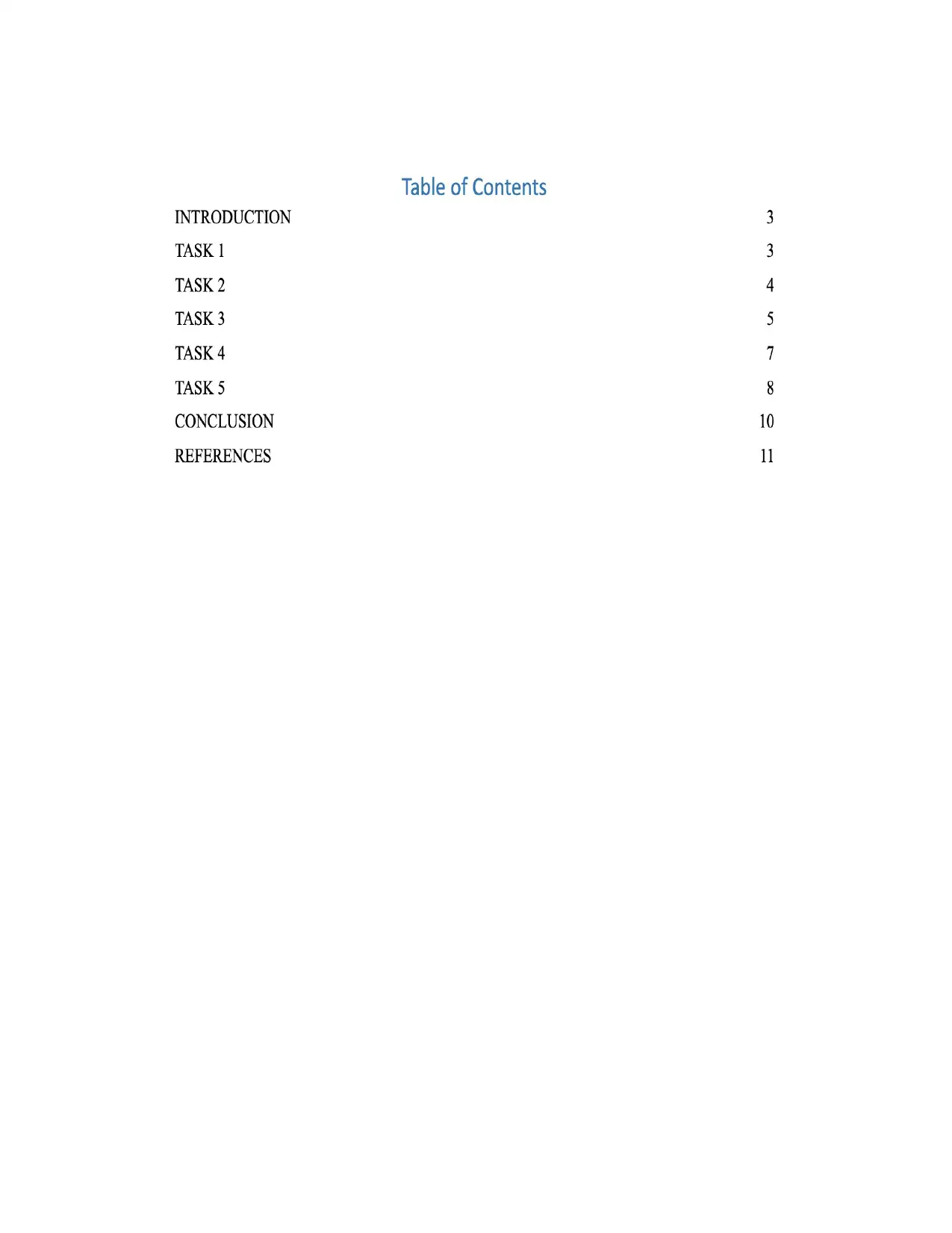
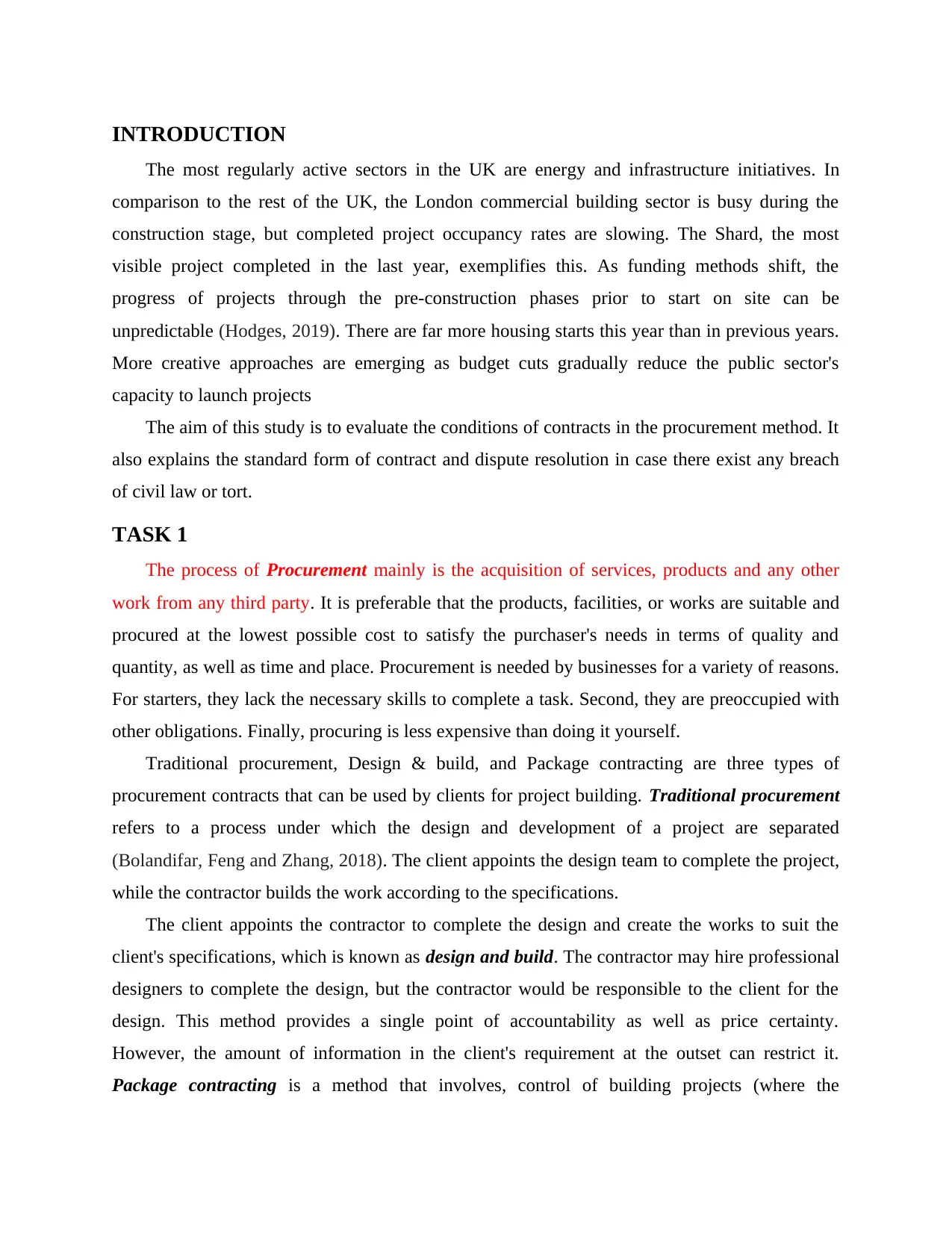
INTRODUCTION
The most regularly active sectors in the UK are energy and infrastructure initiatives. In
comparison to the rest of the UK, the London commercial building sector is busy during the
construction stage, but completed project occupancy rates are slowing. The Shard, the most
visible project completed in the last year, exemplifies this. As funding methods shift, the
progress of projects through the pre-construction phases prior to start on site can be
unpredictable (Hodges, 2019). There are far more housing starts this year than in previous years.
More creative approaches are emerging as budget cuts gradually reduce the public sector's
capacity to launch projects
The aim of this study is to evaluate the conditions of contracts in the procurement method. It
also explains the standard form of contract and dispute resolution in case there exist any breach
of civil law or tort.
TASK 1
The process of Procurement mainly is the acquisition of services, products and any other
work from any third party. It is preferable that the products, facilities, or works are suitable and
procured at the lowest possible cost to satisfy the purchaser's needs in terms of quality and
quantity, as well as time and place. Procurement is needed by businesses for a variety of reasons.
For starters, they lack the necessary skills to complete a task. Second, they are preoccupied with
other obligations. Finally, procuring is less expensive than doing it yourself.
Traditional procurement, Design & build, and Package contracting are three types of
procurement contracts that can be used by clients for project building. Traditional procurement
refers to a process under which the design and development of a project are separated
(Bolandifar, Feng and Zhang, 2018). The client appoints the design team to complete the project,
while the contractor builds the work according to the specifications.
The client appoints the contractor to complete the design and create the works to suit the
client's specifications, which is known as design and build. The contractor may hire professional
designers to complete the design, but the contractor would be responsible to the client for the
design. This method provides a single point of accountability as well as price certainty.
However, the amount of information in the client's requirement at the outset can restrict it.
Package contracting is a method that involves, control of building projects (where the
The most regularly active sectors in the UK are energy and infrastructure initiatives. In
comparison to the rest of the UK, the London commercial building sector is busy during the
construction stage, but completed project occupancy rates are slowing. The Shard, the most
visible project completed in the last year, exemplifies this. As funding methods shift, the
progress of projects through the pre-construction phases prior to start on site can be
unpredictable (Hodges, 2019). There are far more housing starts this year than in previous years.
More creative approaches are emerging as budget cuts gradually reduce the public sector's
capacity to launch projects
The aim of this study is to evaluate the conditions of contracts in the procurement method. It
also explains the standard form of contract and dispute resolution in case there exist any breach
of civil law or tort.
TASK 1
The process of Procurement mainly is the acquisition of services, products and any other
work from any third party. It is preferable that the products, facilities, or works are suitable and
procured at the lowest possible cost to satisfy the purchaser's needs in terms of quality and
quantity, as well as time and place. Procurement is needed by businesses for a variety of reasons.
For starters, they lack the necessary skills to complete a task. Second, they are preoccupied with
other obligations. Finally, procuring is less expensive than doing it yourself.
Traditional procurement, Design & build, and Package contracting are three types of
procurement contracts that can be used by clients for project building. Traditional procurement
refers to a process under which the design and development of a project are separated
(Bolandifar, Feng and Zhang, 2018). The client appoints the design team to complete the project,
while the contractor builds the work according to the specifications.
The client appoints the contractor to complete the design and create the works to suit the
client's specifications, which is known as design and build. The contractor may hire professional
designers to complete the design, but the contractor would be responsible to the client for the
design. This method provides a single point of accountability as well as price certainty.
However, the amount of information in the client's requirement at the outset can restrict it.
Package contracting is a method that involves, control of building projects (where the
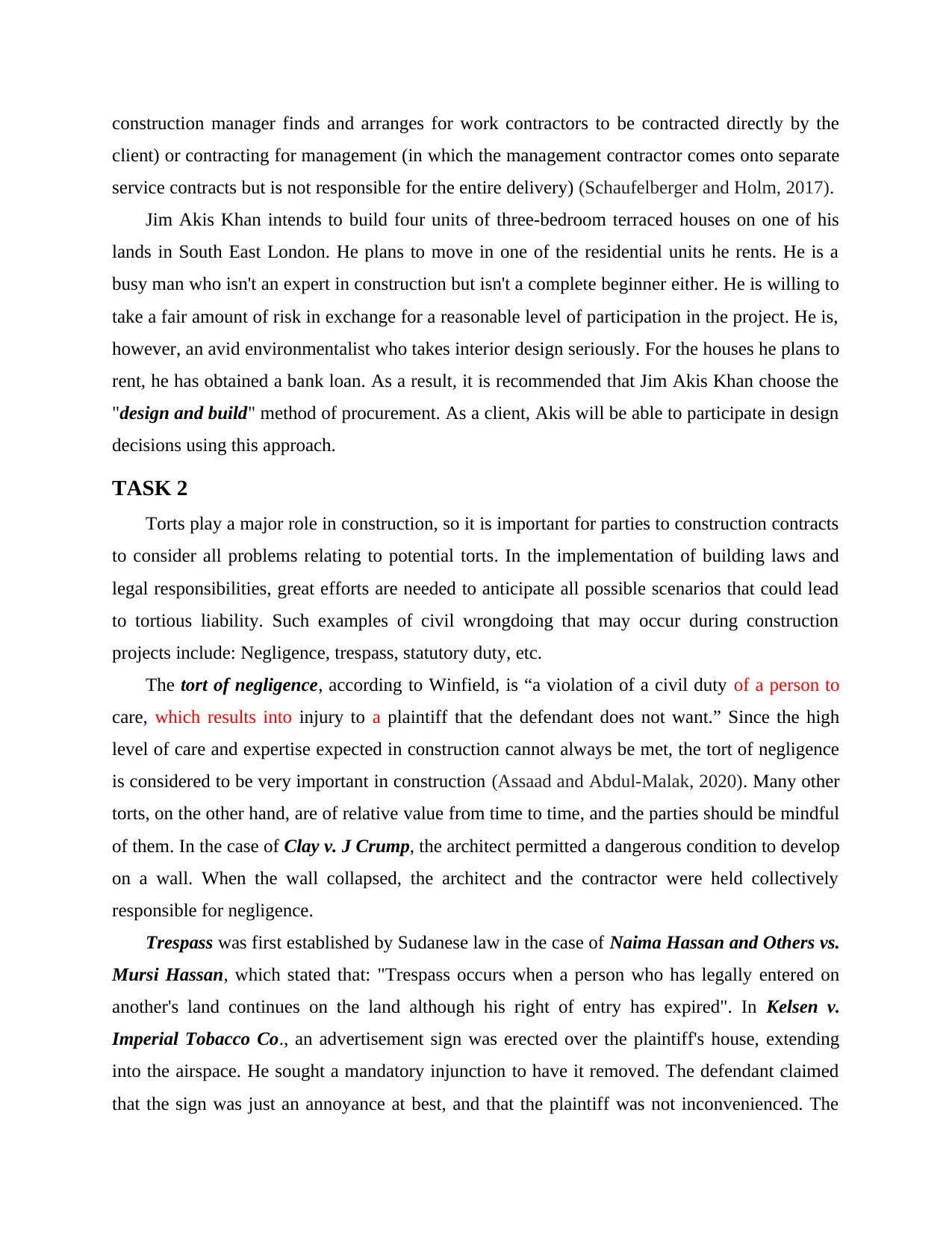
construction manager finds and arranges for work contractors to be contracted directly by the
client) or contracting for management (in which the management contractor comes onto separate
service contracts but is not responsible for the entire delivery) (Schaufelberger and Holm, 2017).
Jim Akis Khan intends to build four units of three-bedroom terraced houses on one of his
lands in South East London. He plans to move in one of the residential units he rents. He is a
busy man who isn't an expert in construction but isn't a complete beginner either. He is willing to
take a fair amount of risk in exchange for a reasonable level of participation in the project. He is,
however, an avid environmentalist who takes interior design seriously. For the houses he plans to
rent, he has obtained a bank loan. As a result, it is recommended that Jim Akis Khan choose the
"design and build" method of procurement. As a client, Akis will be able to participate in design
decisions using this approach.
TASK 2
Torts play a major role in construction, so it is important for parties to construction contracts
to consider all problems relating to potential torts. In the implementation of building laws and
legal responsibilities, great efforts are needed to anticipate all possible scenarios that could lead
to tortious liability. Such examples of civil wrongdoing that may occur during construction
projects include: Negligence, trespass, statutory duty, etc.
The tort of negligence, according to Winfield, is “a violation of a civil duty of a person to
care, which results into injury to a plaintiff that the defendant does not want.” Since the high
level of care and expertise expected in construction cannot always be met, the tort of negligence
is considered to be very important in construction (Assaad and Abdul-Malak, 2020). Many other
torts, on the other hand, are of relative value from time to time, and the parties should be mindful
of them. In the case of Clay v. J Crump, the architect permitted a dangerous condition to develop
on a wall. When the wall collapsed, the architect and the contractor were held collectively
responsible for negligence.
Trespass was first established by Sudanese law in the case of Naima Hassan and Others vs.
Mursi Hassan, which stated that: "Trespass occurs when a person who has legally entered on
another's land continues on the land although his right of entry has expired". In Kelsen v.
Imperial Tobacco Co., an advertisement sign was erected over the plaintiff's house, extending
into the airspace. He sought a mandatory injunction to have it removed. The defendant claimed
that the sign was just an annoyance at best, and that the plaintiff was not inconvenienced. The
client) or contracting for management (in which the management contractor comes onto separate
service contracts but is not responsible for the entire delivery) (Schaufelberger and Holm, 2017).
Jim Akis Khan intends to build four units of three-bedroom terraced houses on one of his
lands in South East London. He plans to move in one of the residential units he rents. He is a
busy man who isn't an expert in construction but isn't a complete beginner either. He is willing to
take a fair amount of risk in exchange for a reasonable level of participation in the project. He is,
however, an avid environmentalist who takes interior design seriously. For the houses he plans to
rent, he has obtained a bank loan. As a result, it is recommended that Jim Akis Khan choose the
"design and build" method of procurement. As a client, Akis will be able to participate in design
decisions using this approach.
TASK 2
Torts play a major role in construction, so it is important for parties to construction contracts
to consider all problems relating to potential torts. In the implementation of building laws and
legal responsibilities, great efforts are needed to anticipate all possible scenarios that could lead
to tortious liability. Such examples of civil wrongdoing that may occur during construction
projects include: Negligence, trespass, statutory duty, etc.
The tort of negligence, according to Winfield, is “a violation of a civil duty of a person to
care, which results into injury to a plaintiff that the defendant does not want.” Since the high
level of care and expertise expected in construction cannot always be met, the tort of negligence
is considered to be very important in construction (Assaad and Abdul-Malak, 2020). Many other
torts, on the other hand, are of relative value from time to time, and the parties should be mindful
of them. In the case of Clay v. J Crump, the architect permitted a dangerous condition to develop
on a wall. When the wall collapsed, the architect and the contractor were held collectively
responsible for negligence.
Trespass was first established by Sudanese law in the case of Naima Hassan and Others vs.
Mursi Hassan, which stated that: "Trespass occurs when a person who has legally entered on
another's land continues on the land although his right of entry has expired". In Kelsen v.
Imperial Tobacco Co., an advertisement sign was erected over the plaintiff's house, extending
into the airspace. He sought a mandatory injunction to have it removed. The defendant claimed
that the sign was just an annoyance at best, and that the plaintiff was not inconvenienced. The
Secure Best Marks with AI Grader
Need help grading? Try our AI Grader for instant feedback on your assignments.
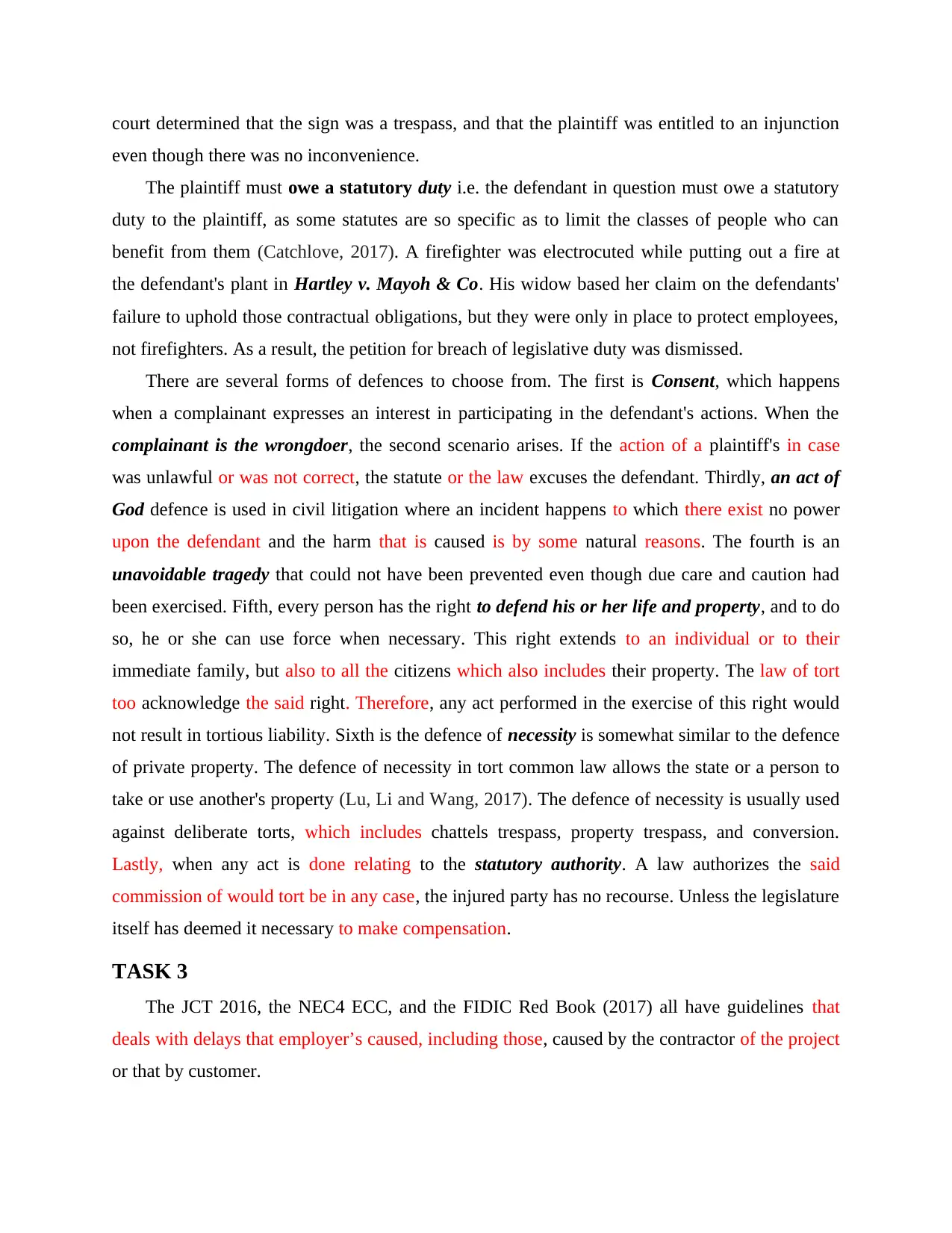
court determined that the sign was a trespass, and that the plaintiff was entitled to an injunction
even though there was no inconvenience.
The plaintiff must owe a statutory duty i.e. the defendant in question must owe a statutory
duty to the plaintiff, as some statutes are so specific as to limit the classes of people who can
benefit from them (Catchlove, 2017). A firefighter was electrocuted while putting out a fire at
the defendant's plant in Hartley v. Mayoh & Co. His widow based her claim on the defendants'
failure to uphold those contractual obligations, but they were only in place to protect employees,
not firefighters. As a result, the petition for breach of legislative duty was dismissed.
There are several forms of defences to choose from. The first is Consent, which happens
when a complainant expresses an interest in participating in the defendant's actions. When the
complainant is the wrongdoer, the second scenario arises. If the action of a plaintiff's in case
was unlawful or was not correct, the statute or the law excuses the defendant. Thirdly, an act of
God defence is used in civil litigation where an incident happens to which there exist no power
upon the defendant and the harm that is caused is by some natural reasons. The fourth is an
unavoidable tragedy that could not have been prevented even though due care and caution had
been exercised. Fifth, every person has the right to defend his or her life and property, and to do
so, he or she can use force when necessary. This right extends to an individual or to their
immediate family, but also to all the citizens which also includes their property. The law of tort
too acknowledge the said right. Therefore, any act performed in the exercise of this right would
not result in tortious liability. Sixth is the defence of necessity is somewhat similar to the defence
of private property. The defence of necessity in tort common law allows the state or a person to
take or use another's property (Lu, Li and Wang, 2017). The defence of necessity is usually used
against deliberate torts, which includes chattels trespass, property trespass, and conversion.
Lastly, when any act is done relating to the statutory authority. A law authorizes the said
commission of would tort be in any case, the injured party has no recourse. Unless the legislature
itself has deemed it necessary to make compensation.
TASK 3
The JCT 2016, the NEC4 ECC, and the FIDIC Red Book (2017) all have guidelines that
deals with delays that employer’s caused, including those, caused by the contractor of the project
or that by customer.
even though there was no inconvenience.
The plaintiff must owe a statutory duty i.e. the defendant in question must owe a statutory
duty to the plaintiff, as some statutes are so specific as to limit the classes of people who can
benefit from them (Catchlove, 2017). A firefighter was electrocuted while putting out a fire at
the defendant's plant in Hartley v. Mayoh & Co. His widow based her claim on the defendants'
failure to uphold those contractual obligations, but they were only in place to protect employees,
not firefighters. As a result, the petition for breach of legislative duty was dismissed.
There are several forms of defences to choose from. The first is Consent, which happens
when a complainant expresses an interest in participating in the defendant's actions. When the
complainant is the wrongdoer, the second scenario arises. If the action of a plaintiff's in case
was unlawful or was not correct, the statute or the law excuses the defendant. Thirdly, an act of
God defence is used in civil litigation where an incident happens to which there exist no power
upon the defendant and the harm that is caused is by some natural reasons. The fourth is an
unavoidable tragedy that could not have been prevented even though due care and caution had
been exercised. Fifth, every person has the right to defend his or her life and property, and to do
so, he or she can use force when necessary. This right extends to an individual or to their
immediate family, but also to all the citizens which also includes their property. The law of tort
too acknowledge the said right. Therefore, any act performed in the exercise of this right would
not result in tortious liability. Sixth is the defence of necessity is somewhat similar to the defence
of private property. The defence of necessity in tort common law allows the state or a person to
take or use another's property (Lu, Li and Wang, 2017). The defence of necessity is usually used
against deliberate torts, which includes chattels trespass, property trespass, and conversion.
Lastly, when any act is done relating to the statutory authority. A law authorizes the said
commission of would tort be in any case, the injured party has no recourse. Unless the legislature
itself has deemed it necessary to make compensation.
TASK 3
The JCT 2016, the NEC4 ECC, and the FIDIC Red Book (2017) all have guidelines that
deals with delays that employer’s caused, including those, caused by the contractor of the project
or that by customer.
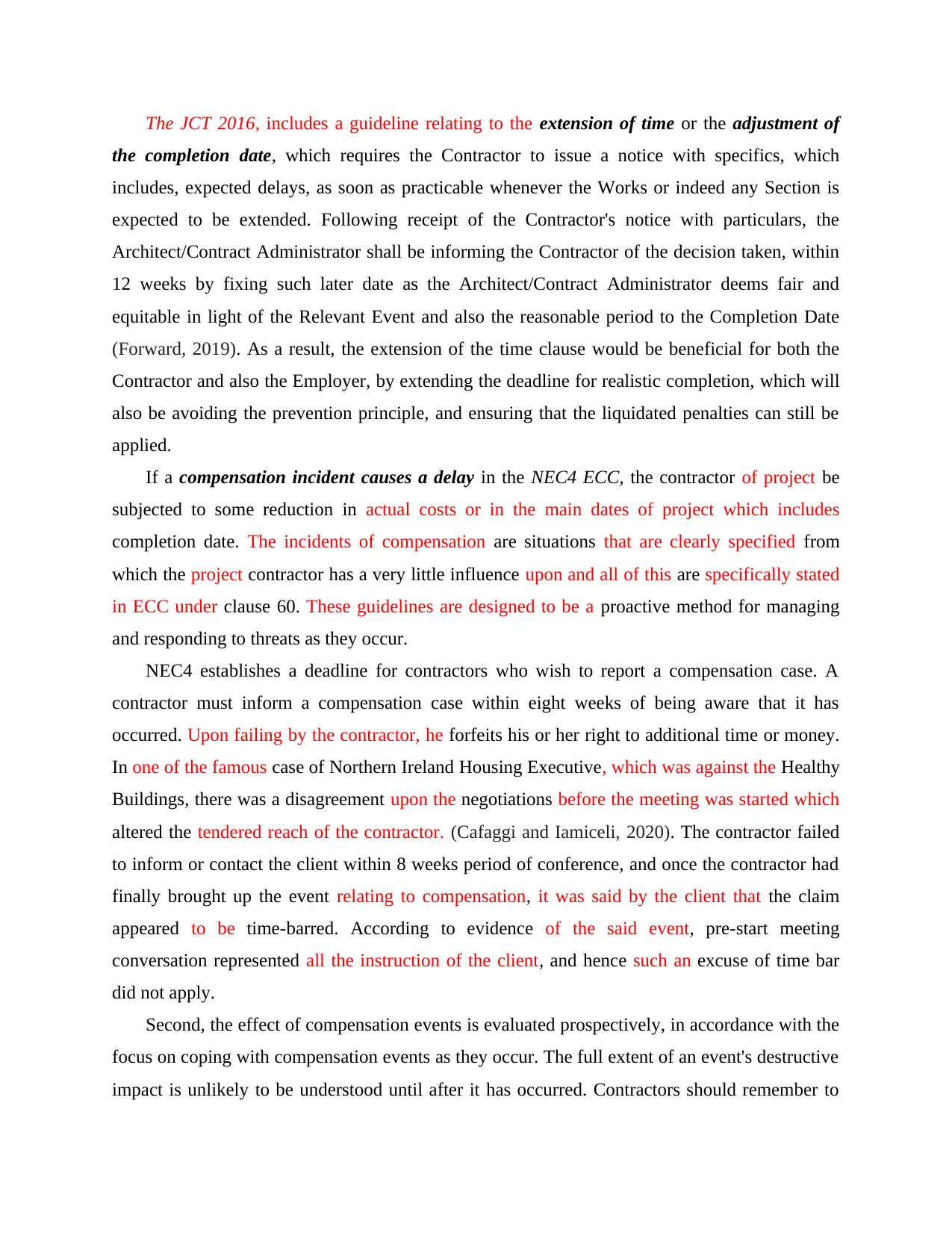
The JCT 2016, includes a guideline relating to the extension of time or the adjustment of
the completion date, which requires the Contractor to issue a notice with specifics, which
includes, expected delays, as soon as practicable whenever the Works or indeed any Section is
expected to be extended. Following receipt of the Contractor's notice with particulars, the
Architect/Contract Administrator shall be informing the Contractor of the decision taken, within
12 weeks by fixing such later date as the Architect/Contract Administrator deems fair and
equitable in light of the Relevant Event and also the reasonable period to the Completion Date
(Forward, 2019). As a result, the extension of the time clause would be beneficial for both the
Contractor and also the Employer, by extending the deadline for realistic completion, which will
also be avoiding the prevention principle, and ensuring that the liquidated penalties can still be
applied.
If a compensation incident causes a delay in the NEC4 ECC, the contractor of project be
subjected to some reduction in actual costs or in the main dates of project which includes
completion date. The incidents of compensation are situations that are clearly specified from
which the project contractor has a very little influence upon and all of this are specifically stated
in ECC under clause 60. These guidelines are designed to be a proactive method for managing
and responding to threats as they occur.
NEC4 establishes a deadline for contractors who wish to report a compensation case. A
contractor must inform a compensation case within eight weeks of being aware that it has
occurred. Upon failing by the contractor, he forfeits his or her right to additional time or money.
In one of the famous case of Northern Ireland Housing Executive, which was against the Healthy
Buildings, there was a disagreement upon the negotiations before the meeting was started which
altered the tendered reach of the contractor. (Cafaggi and Iamiceli, 2020). The contractor failed
to inform or contact the client within 8 weeks period of conference, and once the contractor had
finally brought up the event relating to compensation, it was said by the client that the claim
appeared to be time-barred. According to evidence of the said event, pre-start meeting
conversation represented all the instruction of the client, and hence such an excuse of time bar
did not apply.
Second, the effect of compensation events is evaluated prospectively, in accordance with the
focus on coping with compensation events as they occur. The full extent of an event's destructive
impact is unlikely to be understood until after it has occurred. Contractors should remember to
the completion date, which requires the Contractor to issue a notice with specifics, which
includes, expected delays, as soon as practicable whenever the Works or indeed any Section is
expected to be extended. Following receipt of the Contractor's notice with particulars, the
Architect/Contract Administrator shall be informing the Contractor of the decision taken, within
12 weeks by fixing such later date as the Architect/Contract Administrator deems fair and
equitable in light of the Relevant Event and also the reasonable period to the Completion Date
(Forward, 2019). As a result, the extension of the time clause would be beneficial for both the
Contractor and also the Employer, by extending the deadline for realistic completion, which will
also be avoiding the prevention principle, and ensuring that the liquidated penalties can still be
applied.
If a compensation incident causes a delay in the NEC4 ECC, the contractor of project be
subjected to some reduction in actual costs or in the main dates of project which includes
completion date. The incidents of compensation are situations that are clearly specified from
which the project contractor has a very little influence upon and all of this are specifically stated
in ECC under clause 60. These guidelines are designed to be a proactive method for managing
and responding to threats as they occur.
NEC4 establishes a deadline for contractors who wish to report a compensation case. A
contractor must inform a compensation case within eight weeks of being aware that it has
occurred. Upon failing by the contractor, he forfeits his or her right to additional time or money.
In one of the famous case of Northern Ireland Housing Executive, which was against the Healthy
Buildings, there was a disagreement upon the negotiations before the meeting was started which
altered the tendered reach of the contractor. (Cafaggi and Iamiceli, 2020). The contractor failed
to inform or contact the client within 8 weeks period of conference, and once the contractor had
finally brought up the event relating to compensation, it was said by the client that the claim
appeared to be time-barred. According to evidence of the said event, pre-start meeting
conversation represented all the instruction of the client, and hence such an excuse of time bar
did not apply.
Second, the effect of compensation events is evaluated prospectively, in accordance with the
focus on coping with compensation events as they occur. The full extent of an event's destructive
impact is unlikely to be understood until after it has occurred. Contractors should remember to
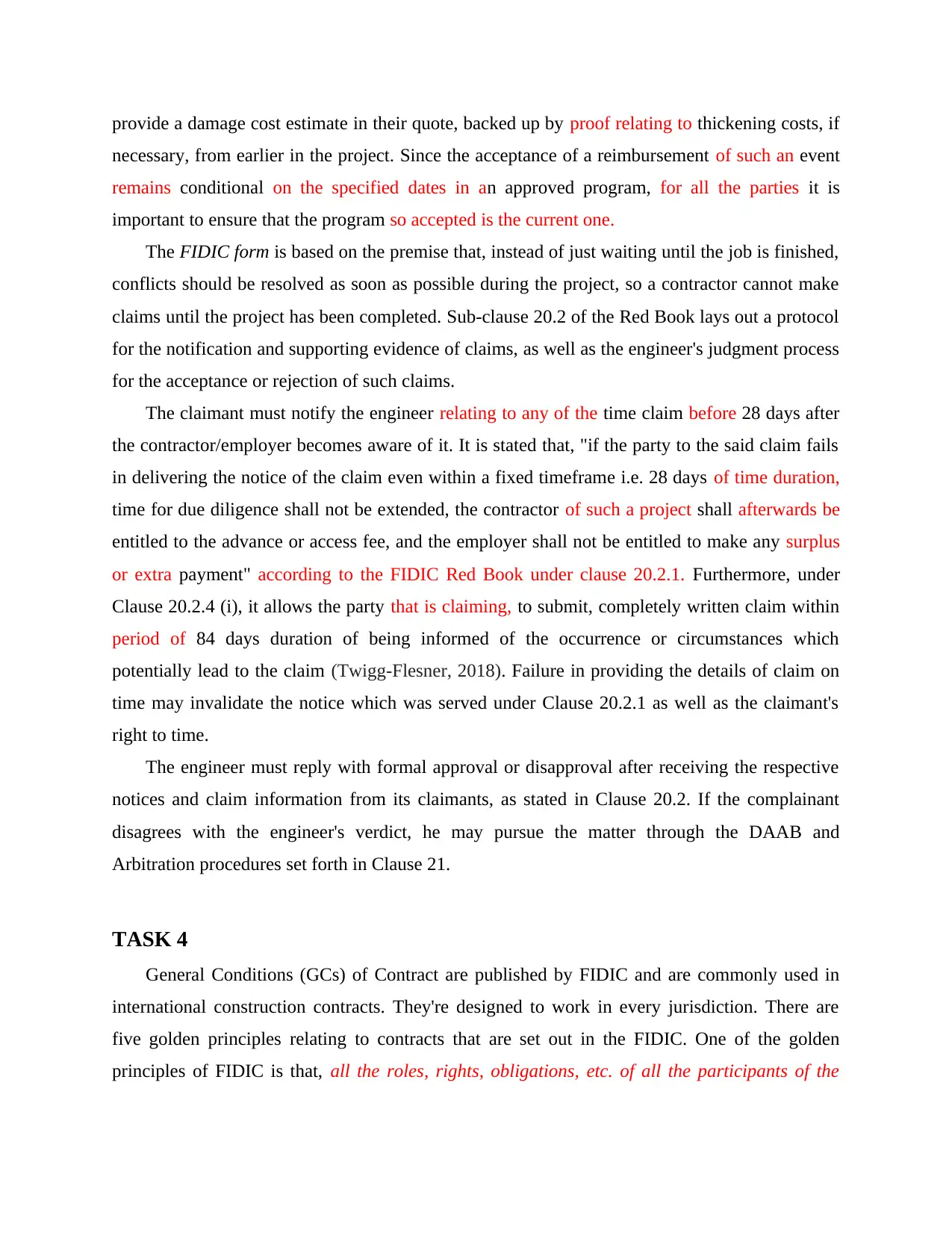
provide a damage cost estimate in their quote, backed up by proof relating to thickening costs, if
necessary, from earlier in the project. Since the acceptance of a reimbursement of such an event
remains conditional on the specified dates in an approved program, for all the parties it is
important to ensure that the program so accepted is the current one.
The FIDIC form is based on the premise that, instead of just waiting until the job is finished,
conflicts should be resolved as soon as possible during the project, so a contractor cannot make
claims until the project has been completed. Sub-clause 20.2 of the Red Book lays out a protocol
for the notification and supporting evidence of claims, as well as the engineer's judgment process
for the acceptance or rejection of such claims.
The claimant must notify the engineer relating to any of the time claim before 28 days after
the contractor/employer becomes aware of it. It is stated that, "if the party to the said claim fails
in delivering the notice of the claim even within a fixed timeframe i.e. 28 days of time duration,
time for due diligence shall not be extended, the contractor of such a project shall afterwards be
entitled to the advance or access fee, and the employer shall not be entitled to make any surplus
or extra payment" according to the FIDIC Red Book under clause 20.2.1. Furthermore, under
Clause 20.2.4 (i), it allows the party that is claiming, to submit, completely written claim within
period of 84 days duration of being informed of the occurrence or circumstances which
potentially lead to the claim (Twigg-Flesner, 2018). Failure in providing the details of claim on
time may invalidate the notice which was served under Clause 20.2.1 as well as the claimant's
right to time.
The engineer must reply with formal approval or disapproval after receiving the respective
notices and claim information from its claimants, as stated in Clause 20.2. If the complainant
disagrees with the engineer's verdict, he may pursue the matter through the DAAB and
Arbitration procedures set forth in Clause 21.
TASK 4
General Conditions (GCs) of Contract are published by FIDIC and are commonly used in
international construction contracts. They're designed to work in every jurisdiction. There are
five golden principles relating to contracts that are set out in the FIDIC. One of the golden
principles of FIDIC is that, all the roles, rights, obligations, etc. of all the participants of the
necessary, from earlier in the project. Since the acceptance of a reimbursement of such an event
remains conditional on the specified dates in an approved program, for all the parties it is
important to ensure that the program so accepted is the current one.
The FIDIC form is based on the premise that, instead of just waiting until the job is finished,
conflicts should be resolved as soon as possible during the project, so a contractor cannot make
claims until the project has been completed. Sub-clause 20.2 of the Red Book lays out a protocol
for the notification and supporting evidence of claims, as well as the engineer's judgment process
for the acceptance or rejection of such claims.
The claimant must notify the engineer relating to any of the time claim before 28 days after
the contractor/employer becomes aware of it. It is stated that, "if the party to the said claim fails
in delivering the notice of the claim even within a fixed timeframe i.e. 28 days of time duration,
time for due diligence shall not be extended, the contractor of such a project shall afterwards be
entitled to the advance or access fee, and the employer shall not be entitled to make any surplus
or extra payment" according to the FIDIC Red Book under clause 20.2.1. Furthermore, under
Clause 20.2.4 (i), it allows the party that is claiming, to submit, completely written claim within
period of 84 days duration of being informed of the occurrence or circumstances which
potentially lead to the claim (Twigg-Flesner, 2018). Failure in providing the details of claim on
time may invalidate the notice which was served under Clause 20.2.1 as well as the claimant's
right to time.
The engineer must reply with formal approval or disapproval after receiving the respective
notices and claim information from its claimants, as stated in Clause 20.2. If the complainant
disagrees with the engineer's verdict, he may pursue the matter through the DAAB and
Arbitration procedures set forth in Clause 21.
TASK 4
General Conditions (GCs) of Contract are published by FIDIC and are commonly used in
international construction contracts. They're designed to work in every jurisdiction. There are
five golden principles relating to contracts that are set out in the FIDIC. One of the golden
principles of FIDIC is that, all the roles, rights, obligations, etc. of all the participants of the
Paraphrase This Document
Need a fresh take? Get an instant paraphrase of this document with our AI Paraphraser
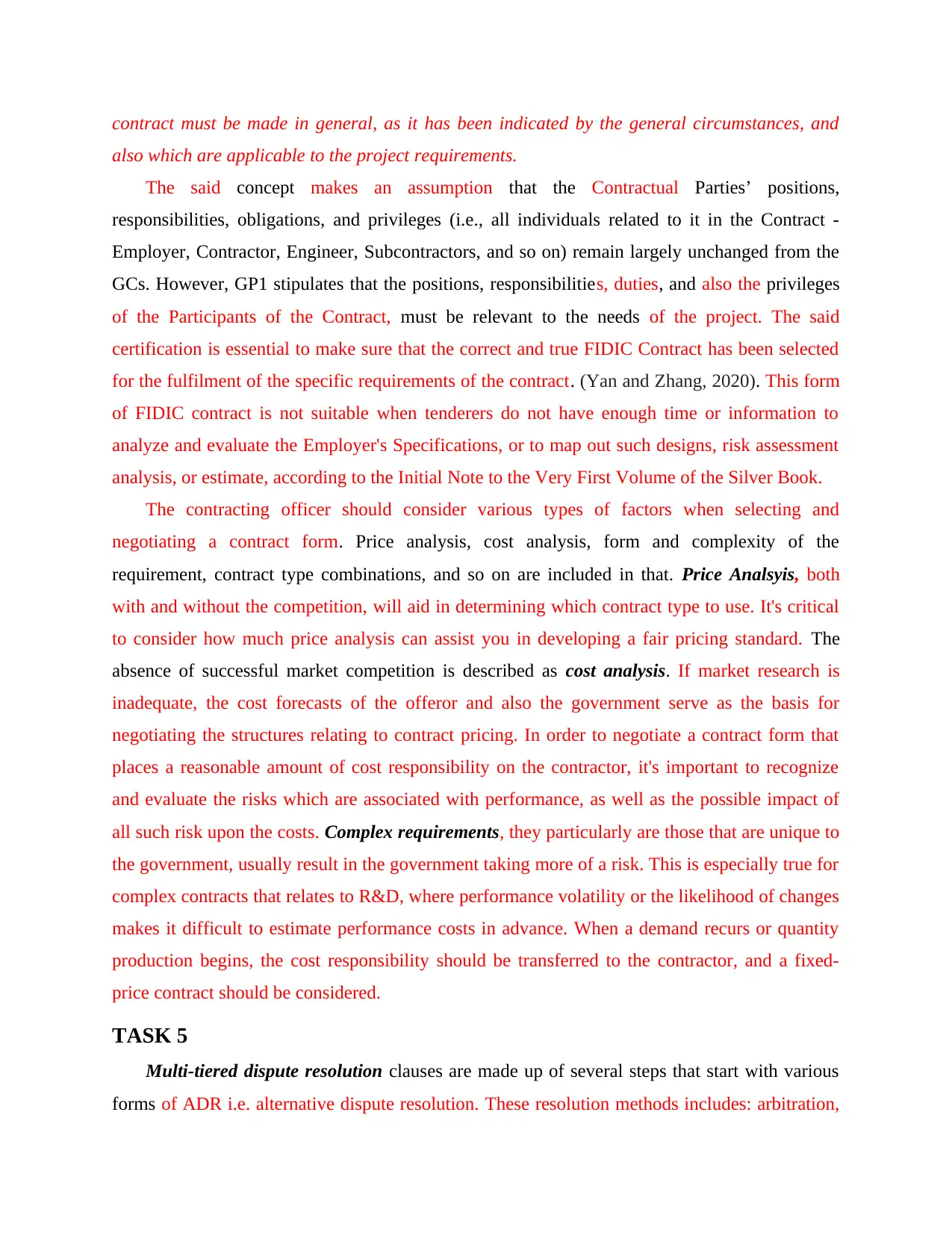
contract must be made in general, as it has been indicated by the general circumstances, and
also which are applicable to the project requirements.
The said concept makes an assumption that the Contractual Parties’ positions,
responsibilities, obligations, and privileges (i.e., all individuals related to it in the Contract -
Employer, Contractor, Engineer, Subcontractors, and so on) remain largely unchanged from the
GCs. However, GP1 stipulates that the positions, responsibilities, duties, and also the privileges
of the Participants of the Contract, must be relevant to the needs of the project. The said
certification is essential to make sure that the correct and true FIDIC Contract has been selected
for the fulfilment of the specific requirements of the contract. (Yan and Zhang, 2020). This form
of FIDIC contract is not suitable when tenderers do not have enough time or information to
analyze and evaluate the Employer's Specifications, or to map out such designs, risk assessment
analysis, or estimate, according to the Initial Note to the Very First Volume of the Silver Book.
The contracting officer should consider various types of factors when selecting and
negotiating a contract form. Price analysis, cost analysis, form and complexity of the
requirement, contract type combinations, and so on are included in that. Price Analsyis, both
with and without the competition, will aid in determining which contract type to use. It's critical
to consider how much price analysis can assist you in developing a fair pricing standard. The
absence of successful market competition is described as cost analysis. If market research is
inadequate, the cost forecasts of the offeror and also the government serve as the basis for
negotiating the structures relating to contract pricing. In order to negotiate a contract form that
places a reasonable amount of cost responsibility on the contractor, it's important to recognize
and evaluate the risks which are associated with performance, as well as the possible impact of
all such risk upon the costs. Complex requirements, they particularly are those that are unique to
the government, usually result in the government taking more of a risk. This is especially true for
complex contracts that relates to R&D, where performance volatility or the likelihood of changes
makes it difficult to estimate performance costs in advance. When a demand recurs or quantity
production begins, the cost responsibility should be transferred to the contractor, and a fixed-
price contract should be considered.
TASK 5
Multi-tiered dispute resolution clauses are made up of several steps that start with various
forms of ADR i.e. alternative dispute resolution. These resolution methods includes: arbitration,
also which are applicable to the project requirements.
The said concept makes an assumption that the Contractual Parties’ positions,
responsibilities, obligations, and privileges (i.e., all individuals related to it in the Contract -
Employer, Contractor, Engineer, Subcontractors, and so on) remain largely unchanged from the
GCs. However, GP1 stipulates that the positions, responsibilities, duties, and also the privileges
of the Participants of the Contract, must be relevant to the needs of the project. The said
certification is essential to make sure that the correct and true FIDIC Contract has been selected
for the fulfilment of the specific requirements of the contract. (Yan and Zhang, 2020). This form
of FIDIC contract is not suitable when tenderers do not have enough time or information to
analyze and evaluate the Employer's Specifications, or to map out such designs, risk assessment
analysis, or estimate, according to the Initial Note to the Very First Volume of the Silver Book.
The contracting officer should consider various types of factors when selecting and
negotiating a contract form. Price analysis, cost analysis, form and complexity of the
requirement, contract type combinations, and so on are included in that. Price Analsyis, both
with and without the competition, will aid in determining which contract type to use. It's critical
to consider how much price analysis can assist you in developing a fair pricing standard. The
absence of successful market competition is described as cost analysis. If market research is
inadequate, the cost forecasts of the offeror and also the government serve as the basis for
negotiating the structures relating to contract pricing. In order to negotiate a contract form that
places a reasonable amount of cost responsibility on the contractor, it's important to recognize
and evaluate the risks which are associated with performance, as well as the possible impact of
all such risk upon the costs. Complex requirements, they particularly are those that are unique to
the government, usually result in the government taking more of a risk. This is especially true for
complex contracts that relates to R&D, where performance volatility or the likelihood of changes
makes it difficult to estimate performance costs in advance. When a demand recurs or quantity
production begins, the cost responsibility should be transferred to the contractor, and a fixed-
price contract should be considered.
TASK 5
Multi-tiered dispute resolution clauses are made up of several steps that start with various
forms of ADR i.e. alternative dispute resolution. These resolution methods includes: arbitration,
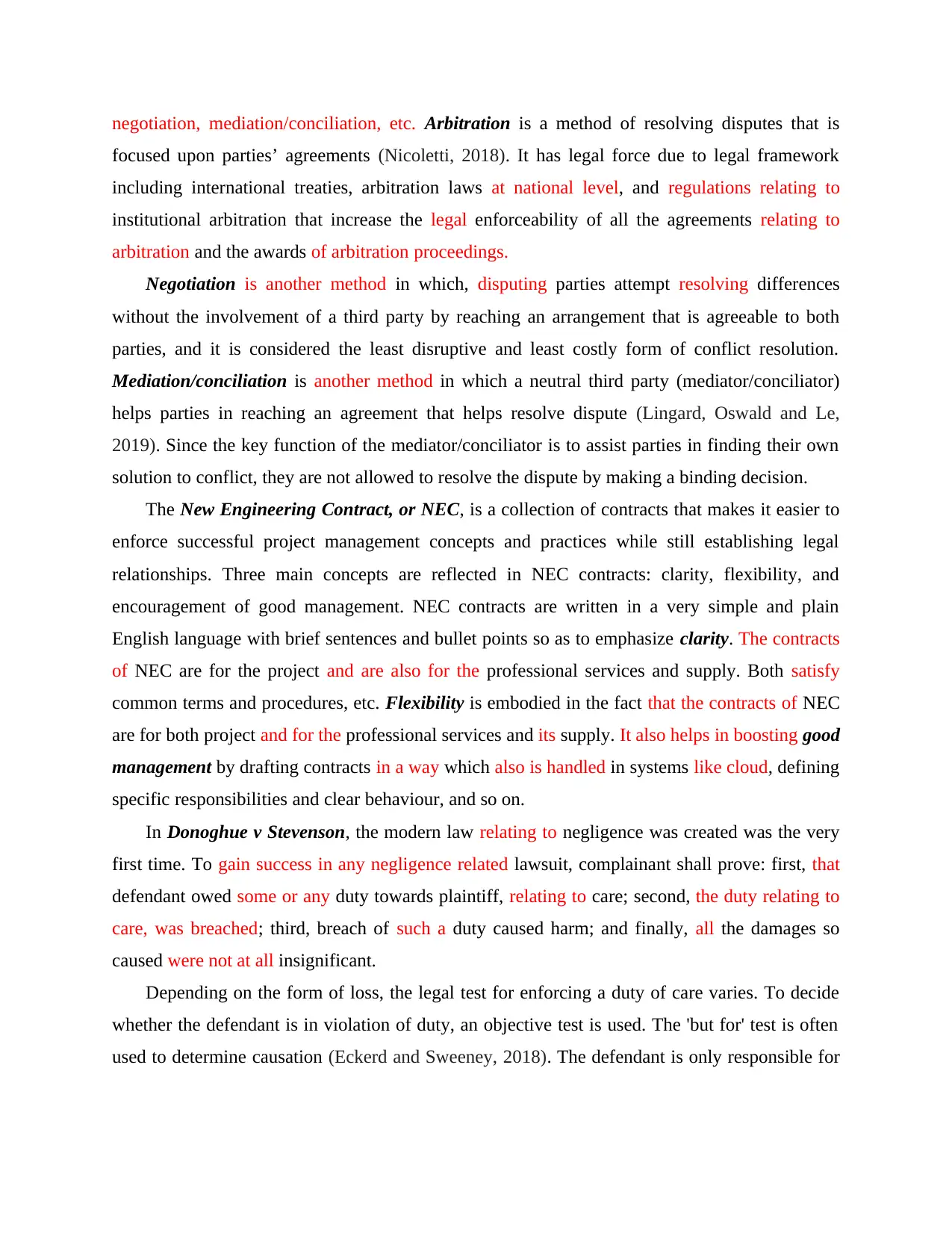
negotiation, mediation/conciliation, etc. Arbitration is a method of resolving disputes that is
focused upon parties’ agreements (Nicoletti, 2018). It has legal force due to legal framework
including international treaties, arbitration laws at national level, and regulations relating to
institutional arbitration that increase the legal enforceability of all the agreements relating to
arbitration and the awards of arbitration proceedings.
Negotiation is another method in which, disputing parties attempt resolving differences
without the involvement of a third party by reaching an arrangement that is agreeable to both
parties, and it is considered the least disruptive and least costly form of conflict resolution.
Mediation/conciliation is another method in which a neutral third party (mediator/conciliator)
helps parties in reaching an agreement that helps resolve dispute (Lingard, Oswald and Le,
2019). Since the key function of the mediator/conciliator is to assist parties in finding their own
solution to conflict, they are not allowed to resolve the dispute by making a binding decision.
The New Engineering Contract, or NEC, is a collection of contracts that makes it easier to
enforce successful project management concepts and practices while still establishing legal
relationships. Three main concepts are reflected in NEC contracts: clarity, flexibility, and
encouragement of good management. NEC contracts are written in a very simple and plain
English language with brief sentences and bullet points so as to emphasize clarity. The contracts
of NEC are for the project and are also for the professional services and supply. Both satisfy
common terms and procedures, etc. Flexibility is embodied in the fact that the contracts of NEC
are for both project and for the professional services and its supply. It also helps in boosting good
management by drafting contracts in a way which also is handled in systems like cloud, defining
specific responsibilities and clear behaviour, and so on.
In Donoghue v Stevenson, the modern law relating to negligence was created was the very
first time. To gain success in any negligence related lawsuit, complainant shall prove: first, that
defendant owed some or any duty towards plaintiff, relating to care; second, the duty relating to
care, was breached; third, breach of such a duty caused harm; and finally, all the damages so
caused were not at all insignificant.
Depending on the form of loss, the legal test for enforcing a duty of care varies. To decide
whether the defendant is in violation of duty, an objective test is used. The 'but for' test is often
used to determine causation (Eckerd and Sweeney, 2018). The defendant is only responsible for
focused upon parties’ agreements (Nicoletti, 2018). It has legal force due to legal framework
including international treaties, arbitration laws at national level, and regulations relating to
institutional arbitration that increase the legal enforceability of all the agreements relating to
arbitration and the awards of arbitration proceedings.
Negotiation is another method in which, disputing parties attempt resolving differences
without the involvement of a third party by reaching an arrangement that is agreeable to both
parties, and it is considered the least disruptive and least costly form of conflict resolution.
Mediation/conciliation is another method in which a neutral third party (mediator/conciliator)
helps parties in reaching an agreement that helps resolve dispute (Lingard, Oswald and Le,
2019). Since the key function of the mediator/conciliator is to assist parties in finding their own
solution to conflict, they are not allowed to resolve the dispute by making a binding decision.
The New Engineering Contract, or NEC, is a collection of contracts that makes it easier to
enforce successful project management concepts and practices while still establishing legal
relationships. Three main concepts are reflected in NEC contracts: clarity, flexibility, and
encouragement of good management. NEC contracts are written in a very simple and plain
English language with brief sentences and bullet points so as to emphasize clarity. The contracts
of NEC are for the project and are also for the professional services and supply. Both satisfy
common terms and procedures, etc. Flexibility is embodied in the fact that the contracts of NEC
are for both project and for the professional services and its supply. It also helps in boosting good
management by drafting contracts in a way which also is handled in systems like cloud, defining
specific responsibilities and clear behaviour, and so on.
In Donoghue v Stevenson, the modern law relating to negligence was created was the very
first time. To gain success in any negligence related lawsuit, complainant shall prove: first, that
defendant owed some or any duty towards plaintiff, relating to care; second, the duty relating to
care, was breached; third, breach of such a duty caused harm; and finally, all the damages so
caused were not at all insignificant.
Depending on the form of loss, the legal test for enforcing a duty of care varies. To decide
whether the defendant is in violation of duty, an objective test is used. The 'but for' test is often
used to determine causation (Eckerd and Sweeney, 2018). The defendant is only responsible for
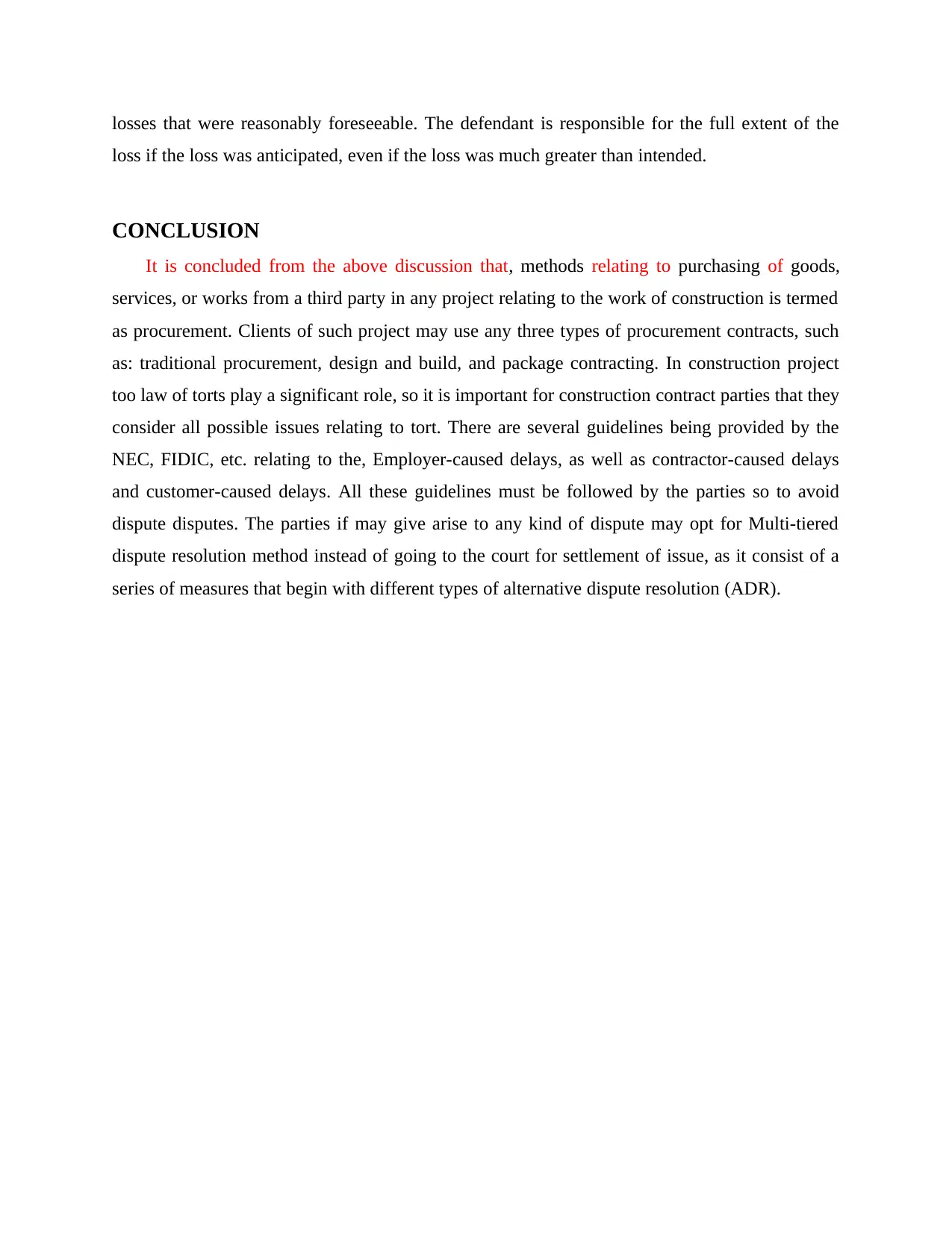
losses that were reasonably foreseeable. The defendant is responsible for the full extent of the
loss if the loss was anticipated, even if the loss was much greater than intended.
CONCLUSION
It is concluded from the above discussion that, methods relating to purchasing of goods,
services, or works from a third party in any project relating to the work of construction is termed
as procurement. Clients of such project may use any three types of procurement contracts, such
as: traditional procurement, design and build, and package contracting. In construction project
too law of torts play a significant role, so it is important for construction contract parties that they
consider all possible issues relating to tort. There are several guidelines being provided by the
NEC, FIDIC, etc. relating to the, Employer-caused delays, as well as contractor-caused delays
and customer-caused delays. All these guidelines must be followed by the parties so to avoid
dispute disputes. The parties if may give arise to any kind of dispute may opt for Multi-tiered
dispute resolution method instead of going to the court for settlement of issue, as it consist of a
series of measures that begin with different types of alternative dispute resolution (ADR).
loss if the loss was anticipated, even if the loss was much greater than intended.
CONCLUSION
It is concluded from the above discussion that, methods relating to purchasing of goods,
services, or works from a third party in any project relating to the work of construction is termed
as procurement. Clients of such project may use any three types of procurement contracts, such
as: traditional procurement, design and build, and package contracting. In construction project
too law of torts play a significant role, so it is important for construction contract parties that they
consider all possible issues relating to tort. There are several guidelines being provided by the
NEC, FIDIC, etc. relating to the, Employer-caused delays, as well as contractor-caused delays
and customer-caused delays. All these guidelines must be followed by the parties so to avoid
dispute disputes. The parties if may give arise to any kind of dispute may opt for Multi-tiered
dispute resolution method instead of going to the court for settlement of issue, as it consist of a
series of measures that begin with different types of alternative dispute resolution (ADR).
Secure Best Marks with AI Grader
Need help grading? Try our AI Grader for instant feedback on your assignments.
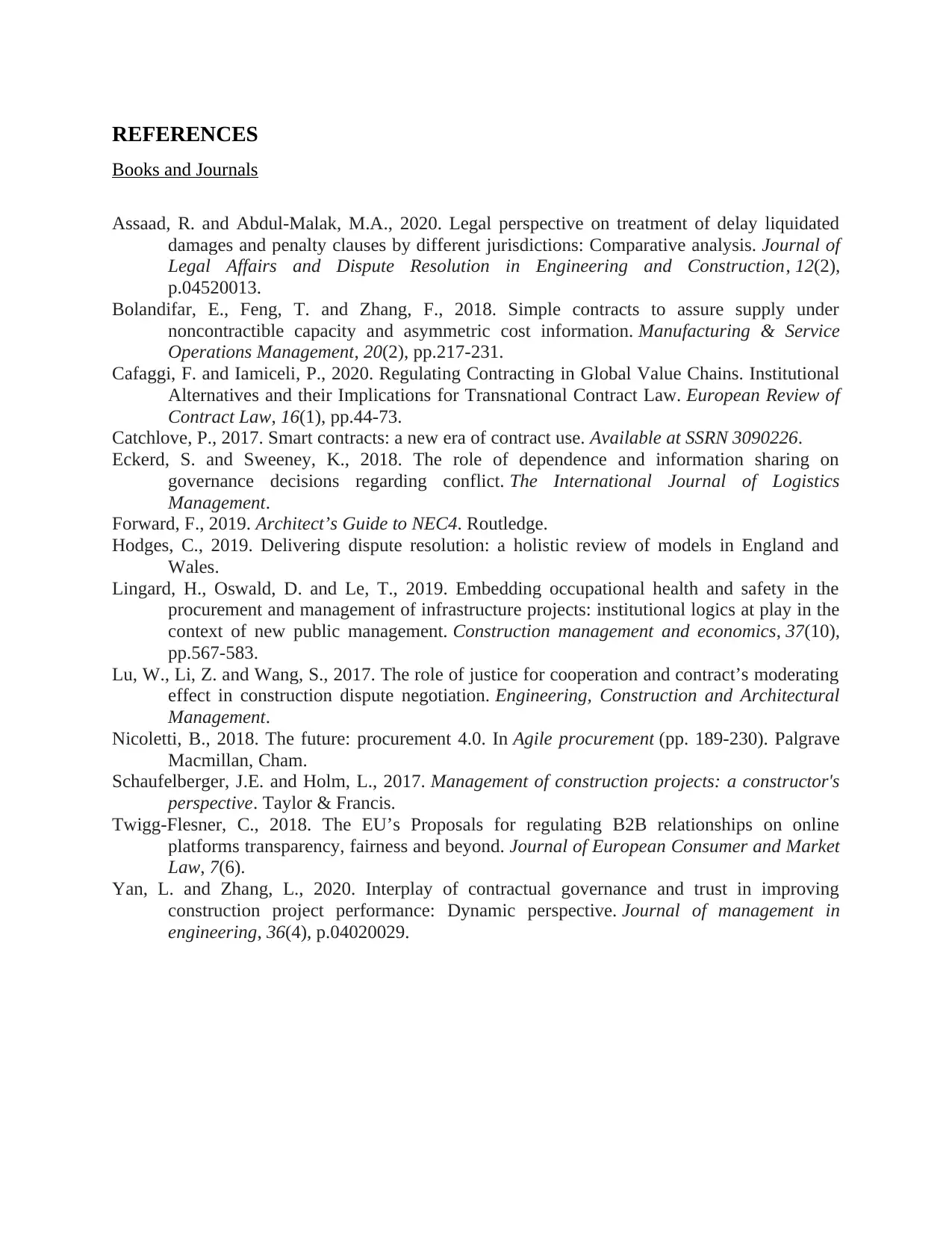
REFERENCES
Books and Journals
Assaad, R. and Abdul-Malak, M.A., 2020. Legal perspective on treatment of delay liquidated
damages and penalty clauses by different jurisdictions: Comparative analysis. Journal of
Legal Affairs and Dispute Resolution in Engineering and Construction, 12(2),
p.04520013.
Bolandifar, E., Feng, T. and Zhang, F., 2018. Simple contracts to assure supply under
noncontractible capacity and asymmetric cost information. Manufacturing & Service
Operations Management, 20(2), pp.217-231.
Cafaggi, F. and Iamiceli, P., 2020. Regulating Contracting in Global Value Chains. Institutional
Alternatives and their Implications for Transnational Contract Law. European Review of
Contract Law, 16(1), pp.44-73.
Catchlove, P., 2017. Smart contracts: a new era of contract use. Available at SSRN 3090226.
Eckerd, S. and Sweeney, K., 2018. The role of dependence and information sharing on
governance decisions regarding conflict. The International Journal of Logistics
Management.
Forward, F., 2019. Architect’s Guide to NEC4. Routledge.
Hodges, C., 2019. Delivering dispute resolution: a holistic review of models in England and
Wales.
Lingard, H., Oswald, D. and Le, T., 2019. Embedding occupational health and safety in the
procurement and management of infrastructure projects: institutional logics at play in the
context of new public management. Construction management and economics, 37(10),
pp.567-583.
Lu, W., Li, Z. and Wang, S., 2017. The role of justice for cooperation and contract’s moderating
effect in construction dispute negotiation. Engineering, Construction and Architectural
Management.
Nicoletti, B., 2018. The future: procurement 4.0. In Agile procurement (pp. 189-230). Palgrave
Macmillan, Cham.
Schaufelberger, J.E. and Holm, L., 2017. Management of construction projects: a constructor's
perspective. Taylor & Francis.
Twigg-Flesner, C., 2018. The EU’s Proposals for regulating B2B relationships on online
platforms transparency, fairness and beyond. Journal of European Consumer and Market
Law, 7(6).
Yan, L. and Zhang, L., 2020. Interplay of contractual governance and trust in improving
construction project performance: Dynamic perspective. Journal of management in
engineering, 36(4), p.04020029.
Books and Journals
Assaad, R. and Abdul-Malak, M.A., 2020. Legal perspective on treatment of delay liquidated
damages and penalty clauses by different jurisdictions: Comparative analysis. Journal of
Legal Affairs and Dispute Resolution in Engineering and Construction, 12(2),
p.04520013.
Bolandifar, E., Feng, T. and Zhang, F., 2018. Simple contracts to assure supply under
noncontractible capacity and asymmetric cost information. Manufacturing & Service
Operations Management, 20(2), pp.217-231.
Cafaggi, F. and Iamiceli, P., 2020. Regulating Contracting in Global Value Chains. Institutional
Alternatives and their Implications for Transnational Contract Law. European Review of
Contract Law, 16(1), pp.44-73.
Catchlove, P., 2017. Smart contracts: a new era of contract use. Available at SSRN 3090226.
Eckerd, S. and Sweeney, K., 2018. The role of dependence and information sharing on
governance decisions regarding conflict. The International Journal of Logistics
Management.
Forward, F., 2019. Architect’s Guide to NEC4. Routledge.
Hodges, C., 2019. Delivering dispute resolution: a holistic review of models in England and
Wales.
Lingard, H., Oswald, D. and Le, T., 2019. Embedding occupational health and safety in the
procurement and management of infrastructure projects: institutional logics at play in the
context of new public management. Construction management and economics, 37(10),
pp.567-583.
Lu, W., Li, Z. and Wang, S., 2017. The role of justice for cooperation and contract’s moderating
effect in construction dispute negotiation. Engineering, Construction and Architectural
Management.
Nicoletti, B., 2018. The future: procurement 4.0. In Agile procurement (pp. 189-230). Palgrave
Macmillan, Cham.
Schaufelberger, J.E. and Holm, L., 2017. Management of construction projects: a constructor's
perspective. Taylor & Francis.
Twigg-Flesner, C., 2018. The EU’s Proposals for regulating B2B relationships on online
platforms transparency, fairness and beyond. Journal of European Consumer and Market
Law, 7(6).
Yan, L. and Zhang, L., 2020. Interplay of contractual governance and trust in improving
construction project performance: Dynamic perspective. Journal of management in
engineering, 36(4), p.04020029.
1 out of 11
Related Documents
Your All-in-One AI-Powered Toolkit for Academic Success.
+13062052269
info@desklib.com
Available 24*7 on WhatsApp / Email
![[object Object]](/_next/static/media/star-bottom.7253800d.svg)
Unlock your academic potential
© 2024 | Zucol Services PVT LTD | All rights reserved.





